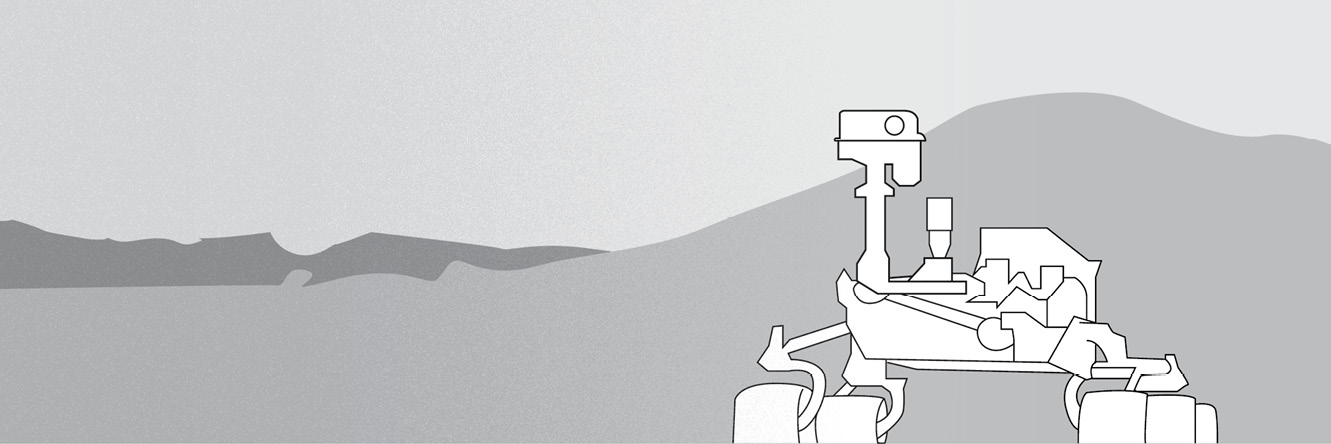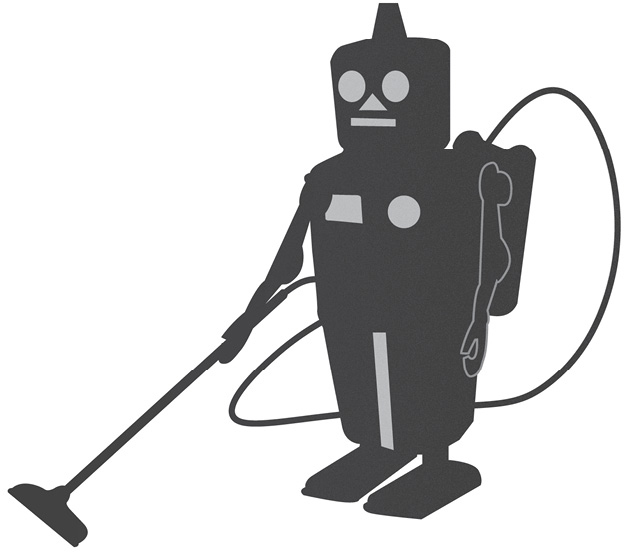23 How Do You Drive a Robot on Mars?
Robots are the true space explorers. They’ve been to more worlds more often than humans ever have. They’ve even gone where no human being ever will go—into the stormy clouds of mighty Jupiter, through the rings of Saturn, and out to the cold, dark reaches of Pluto. Robots went to the moon before people did to check it out and make sure that it was safe to land there.
But building robots and operating them on worlds that are millions of kilometers away from Earth is not easy. If something goes wrong with the robot, you can’t run up and fix it. The robots we send into space have to be strong, capable, and somewhat smart.
So what is a robot anyway? The word “robot” goes back hundreds of years to the Czech word robota, which means forced labor or drudgery. At first, people thought robots would work like human slaves and that they would look and act like we do. But robots of that variety are made mostly for entertainment—they’re useful in movies, not on other planets.


When it comes to working in space, robots come in many different forms, depending on what they’re meant to do. Some have solar wings and antennae sticking out in all directions. That variety is not built to land on planets but to fly past or orbit them and examine the planet from above.
Others have wheels so they can make landings. Rovers—such as Spirit and Opportunity, which both landed on Mars in January 2004, and Curiosity, which touched down there in 2012—have wheels to drive around and moveable heads with camera eyes so they can see where they’re going. They also have an arm to reach out and sample rocks. The robots’ eyes are up high—about the same height above the ground as human eyes—so the pictures they take show what the landscape would look like if you were standing on Mars. Rovers are the most complicated and talented robots that are currently sent into space.
Driving a car on Mars is not the same as driving a radio-controlled car on Earth. Mars is so far away that it takes time for a controller’s radio signal to travel across space and reach the robot. The travel time between controller to rover is up to twenty minutes. If the controller sees the rover heading into danger and tells it to stop, the robot won’t receive the message until it’s too late. For this reason, robots need independent brains. They need some intelligence of their own to recognize danger and avoid it.
Some robots have all their actions programmed into their computers ahead of time so that when they arrive in space, the program runs by itself. The robot fires its engines and turns on its cameras and other instruments at exactly the right time. This takes a lot of planning ahead because if the timing isn’t right, the robot might do the wrong thing at the wrong time and not even know it.
Rovers that drive around on other planets have such intelligent computer brains that some have compared them to obedient pets. They’re given instructions on where to go and what to do, then left on their own to do those things. It’s like a dog fetching a stick. The dog knows how to run after the stick, pick it up, and bring it back. All you have to do is throw the stick. The dog does the rest. Rovers on Mars operate the same way.
Scientists on Earth examine pictures the rover takes of the land around itself and decide where they would like it to go. If there’s an interesting rock nearby, the controller will send signals to the rover to drive toward it. But while the rover is driving, it’s also making sure it doesn’t run into anything along the way. If it comes to a boulder that is too large to drive over, it will either decide to drive around the obstacle or stop and phone home to ask what to do next.
The rover uses cameras, lasers, and other sensors to look at its environment as it drives along, making a map of the land and choosing the best route. This takes a lot of computer power, which is why rovers move very slowly, about the speed you would if you were crawling along a bumpy floor on all fours.
But rovers move a lot more quickly when they’re landing. Scientists call it the seven minutes of terror. That’s how long it takes a robot to go from floating in space all the way to the ground on Mars. During that short time, the rover comes screaming into the top of the Martian atmosphere at more than twenty thousand kilometers per hour and has to perform a series of maneuvers involving a heat shield, parachutes, and air bags to come to a dead stop on the ground. If anything goes wrong on the way down, the mission is over. And during this dangerous descent, the rover is entirely on its own.
I was fortunate enough to be among a large group of reporters and special guests at the Jet Propulsion Laboratory in California, which was mission control for the landing of Spirit on Mars on January 4, 2004. Excitement filled the air because we were about to witness a landing on another world, where we would be the first to see an alien landscape that human eyes had never seen before. But first, we had to get the rover there.
The spacecraft, which looked a lot like a flying saucer out of a science fiction movie, held the lander Spirit inside it. The capsule had been launched from Earth about seven months earlier and spent all that time coasting through the cold vacuum of space between Earth and Mars. Now it was time for the hardest part.
More than half of the robots sent to Mars have failed. They either missed the planet, crashed onto the surface, or simply lost contact along the way. Landing on another world is not easy.
In a separate room, mission controllers were watching their computer monitors carefully. Everyone was hoping the mission would go according to plan. If something went wrong, the signal delay between Earth and Mars meant the controllers could not do anything about it. The rover was on its own—all the scientists and the rest of us could do was watch.
A mission controller announced, “Contact with the atmosphere.”
A cheer went up in the room. The spacecraft had reached Mars. But the tension continued to rise as the rover, tucked into its protective capsule, was surrounded by hot plasma as the Martian air burned around it.
The round capsule functioned as a heat shield. It was designed to protect its precious cargo from temperatures that, because of the friction with the air, could reach more than two thousand degrees Celsius. To do that, the saucer had to hit the atmosphere at just the right angle. If it dove in too steep, it would burn up and be destroyed. If it came in at too shallow an angle, it would skip off the top of the atmosphere like a stone off water and bounce back into space. Thankfully, Spirit was right on target.
A fireball surrounded the capsule, turning the spacecraft into a bright meteor streaking through the Martian sky. That air friction also slammed on the brakes, slowing the spacecraft down and putting pressure on the lander. It was the same feeling as when you’re forced against the seat belt of a car after a driver hits the brakes, except the rover felt many times the force of gravity.
After surviving the fireball stage, the capsule was still traveling more than two thousand kilometers per hour. A gigantic parachute popped open, slowing it down further. Even with that, though, the capsule was still eleven kilometers above the ground and moving faster than the speed of sound.
When the capsule was eight kilometers above the ground, the heat shield dropped off because it was no longer needed. The lander, now exposed to the Martian atmosphere, saw the red ground of Mars for the first time. A radar turned on so the robot could tell how high it was and determine when to turn on its rocket engine for the final descent.
If the lander was coming down on Earth, the parachute would gently lower it all the way to the ground. But, unfortunately, the air on Mars is much thinner, so a parachute won’t slow down the capsule enough for a safe landing.
At each announcement—“Parachute deploy!” then “Heat shield eject!”—another cheer filled the room. We were all hoping for the best as the robot made its dash to the ground. With less than a kilometer to go, the lander was lowered below the parachute on a long cable. Six huge airbags were inflated, completely surrounding the lander until it looked like a giant cluster of grapes. Rocket engines attached to the cable fired to bring the lander to a stop just above the ground. Then the cable was cut, and the whole device dropped like a giant beach ball onto the ground.
“Contact!” yelled the mission controller. Everyone, scientists included, jumped up and waved their arms in the air, cheering wildly.
We’d landed on Mars!
Then the controller’s voice came over the speaker again. “Okay, everyone, calm down. We’ve lost signal.”
Oh no!
Had the lander crashed at the last second? Was the whole mission lost because of something that happened right as the rover touched the ground?
A hush came over the room as everyone thought about how sad it would be if everything was lost after so much work by so many people.
“It is bouncing on the surface. We have to wait until it stops.”
Of course! That’s what the airbags were for. They cushioned the impact with the ground, but they also made the lander bounce. In the low Martian gravity—which is only one-third as strong as it is on Earth—the first bounce sent the lander flying back into the air up to the height of a four-story building. There was another bounce after that, and another and another.

Finally, after several minutes, we got the signal that the rover was safe on Mars. Cheers went up all around once again, this time for real. All eyes were glued to the television monitors as the first picture arrived—an image of the rover itself, its deflated airbags along the edge of the frame. The image proved that the rover was right-sided up and healthy. It could have tumbled over on its side or slid between some rocks, but all looked clear.
Then, as the rover lifted its mechanical head and looked out to the horizon, we saw flat ground with hills off in the distance. We were vicariously standing on another world, taking a look around. It was as if we were there with the rover, standing on Mars.
In the future, other robots will venture out and explore strange new worlds to prepare the way for human beings to follow later, just as Spirit did. And even when we do land on other worlds, we will likely have robotic helpers with us to assist in the work. In some cases, robots will be able to go places we can’t, like into the poisonous clouds of Venus or the super-cold liquid methane lakes on Titan, a moon of Saturn.
Human astronauts are often called heroes because of the dangerous work they do. Robots do even more, but they can’t appreciate where they are and what they’ve done.
Or can they?